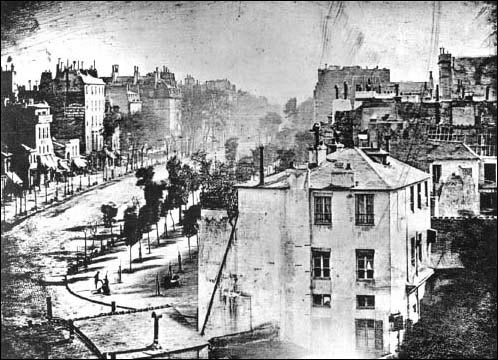Stumbled upon (literally, not via StumbeUpon!) it while looking for a place to develop a b/w film in Athens…
1826
The picture below is reputed to be the world’s first photograph. It was taken in 1826 and was developed by French photographer Joseph Nicéphore Niépce. He called this process “heliography” or sun drawing and the entire process took eight hours.
——————
1869
Before the Autochrome process was perfected in France, this photograph of a landscape in Southern France was taken. No, it is not hand-tinted. This is a color-photograph. (Note: It was published in a Time/Life Book entitled “Color” in 1972, “courtesey of George Eastman House, Paulus Lesser.”) You are looking at the birth of color photography seven years after the American Civil War. 130 years ago this view of Angouleme, France, was created by a “subtractive” method. This is the basis for all color photography, even today. It was taken by Louis Ducos du Hauron who proposed the method in 1869. It was not until the 1930’s that this method was perfected for commercial use.
——————-
1838
This is one of the, if not the, oldest known photograph of a human being in existence. It depends on how one defines photograph, but this was taken by Louis Jacques-Mande Daguerre in 1838. (The fellow the daguerreotype was named after.) This is a photo of the Boulevard du Temple in Paris. This is a busy street and there was tons of traffic, but since the exposure was so long, about 15-20 minutes, none of the moving figures can be seen. The only people visible are a guy getting his boots polished and the bootblack. Who was this nameless gentleman or the bootblack? No one knows. I’m sure they never imagined that they had been immortalized, albeit anonymously, by a clever scientist testing his newly discovered method of preserving moments in time.
It was a different world then. The only motorized transportation was the railroad, and even it was in its infancy. Horses and sailing ships were still the primary means of getting around, the typical person probably never travelled more than 50 miles from where they were born. The first Atlantic steamship service started this year though, so the future was on the way. The telegraph had been invented, but the first commercial telegraph operations were a year away. There were commercial semaphore telegraphs operating, so it was possible to send a message over some distance for a price.
The first accurate measurement of the distance to a nearby star was calculated in 1838, the intellectuals were beginning to grasp just how big the universe really was. Though the discovery that there were other galaxies besides our own was still decades away. The first mass produced clocks were flooding markets in England and America, for the first time commoners could have a clock in their homes. Though it would be some decades before time zone was invented, clocks were set to local noon. They were the PCs of their day no doubt. What we would call a modern bicycle was still a year away, the bicycles of the era were propelled by pushing the ground with one’s feet. Gads.
Napoleon was still on everyone’s minds no doubt, the way Hitler is now the demon du jour, having been defeated less than three decades before. Slavery had been abolished in most of the civilized world, with the exception of the USA. In England Queen Victoria’s reign began the year before. I’m sure no one guessed she would reign until 1901, 63 years, the longest reign of any British Monarch. I doubt she or anyone guessed at the changes that would take place in her lifetime. And neither Germany nor Italy existed yet yet, both were a dozen or more smaller independent nations.
Here is a map of Europe in 1815. It would have looked the same in 1838 if I am not mistaken. America was a lot smaller then too, and Texas was an independent nation. In any event, nothing particularly profound about this post. I am just trying to share my love of history in general and old photographs in particular. (I’ve linked to this before, but here again is a lovely site about the history of photography.) Every age thinks it is at the end of history, and at the time, they were.
Puts some perspective into digital photography… Do you think people in 2180 will find anything interesting that exists today in my flickr profile? I wonder if and how today’s technology will be compatible with the mediums of the future…
Big thank you to my sources (in order) and to (CTRL+C)+(CTRL+V):
3rd photo <- Doug’s Darkworld



